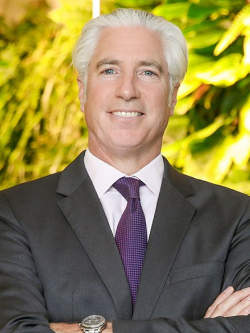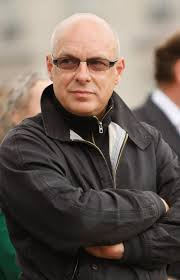
The right event done well is as powerful a driver of the brand of a place as you’re likely to get anywhere, according to one of the original architects of the world’s biggest festival of lights, creativity and ideas.

Geoff Parmenter has 30 years of experience in tourism, entertainment and sport both in Australia and overseas, and as Chief Executive of Events NSW from 2007-2011 led development of the state’s first structured annual events calendar, which today includes Vivid Sydney as a permanent fixture.
Parmenter will share the stage with Vivid’s current director Gill Minervinni at the Place Branding Conference in June to reflect on the evolution of the hugely successful festival over the years, and discuss the benefits a well-staged event can bring.
See the full Place Branding Australia program here.
Events, Parmenter says, are about what a place does, rather than what it says it does.
“You can run advertising to tell people what your place is about, and I’m not saying that it’s not a good idea to run advertising,” he told Government News.
“But actually hosting an event that reaches the right people is a particularly authentic, and therefore effective and impactful way of demonstrating what your place is about.”
A new way of thinking about events
Vivid was developed at a time when the prevailing approach towards building a calendar of events was to go out and buy them, but its success has been in bucking the trend, Parmenter says.
His cites the example of the Kennett government in Victoria buying the Grand Prix from Adelaide for an undisclosed amount in 1993, which saw the marquee event shifted to a rebuilt Albert Park Circuit in Melbourne.
“If you want to build a program of activity for the sake of having a calendar, that’s still an effective way of doing it,” he says.
“But it’s not a cost efficient way of doing it. And that’s because the better job you do at hosting footloose events – which can go from place to place – the more expensive it becomes for you to hang on to them.
“But if you design a bespoke event from scratch, one that’s intended to do a particular job explicitly for your place, and you own it, then the value accrues to your place.”
Sydney 2000 – the ultimate place branding exercise
That was the logic that drove the establishment of Events NSW in 2007 in the fading afterglow of the Sydney 2000 Olympics.
While the Sydney Games ultimately drove value for the IOC and the Olympic brand, it was also a hugely successful example – perhaps the ultimate example – of place branding for Sydney and Australia.
“The Games did a great job in helping to put some depth behind Sydney as a destination brand,” Parmenter says.
“The reason for that is that there was a very strong natural alignment between the Olympic brand and Sydney’s identity. One of the things the Olympics stands for is international belonging and diversity, and every piece of brand research you see about Sydney elevates that celebration of diversity.
The Games did a great job in helping to put some depth behind Sydney as a destination brand.
Geoff Parmenter
“I think that translated into a really warm welcome. We love hosting people. By International standards I think we’re a pretty welcoming mob, and that aspect of the Games brand suited us very well.”
But after the Games, as Melbourne surged ahead building an event calendar that helped it emerge from the doldrums of the early 1990s, Sydney put its feet up.
“I’m not saying that the Olympics didn’t give Sydney a nice platform,” Parmenter says. “It did. But after a couple of years post-Games, we were really quite passive in the space while Victoria had really hit its straps.
Enter Events NSW
Events NSW, an initiative of the then Iemma government, was set up seven years after the Games with Parmenter at its helm.
“New South Wales had never had an organisation that was specifically and deliberately tasked with building a calendar to represent the place and to drive visitation and the economic benefit that attracted,” he says.
“We were lucky we had a Board that embraced the strategy of developing bespoke events rather than just going out into what was by then a pretty mature event procurement marketplace to try and buy stuff.”
Vivid had its beginning as an amalgamation of several content streams that had been brought to Events NSW, Parmenter says.
We put those two things together and said, look, couldn’t we create a festival of light and music?
Geoff Parmenter
“You had a group of people who wanted to stage a smart light festival with lighting installations that demonstrated innovative ways of using sustainable sources to do interesting stuff with light.
“They wanted to do a set of light installations around the Harbour foreshore, and they also wanted to light the Opera House sails.”

The Opera House was lukewarm on the idea of the sails, but the then CEO Richard Evans was pursuing an idea of making the venue more accessible to the person in the street by staging a popular winter music festival.
“We put those two things together and said, look, couldn’t we create a festival of light and music?” Parmenter says.
“The trade off would be that you would perhaps look to have a curator that has the potential to oversee the lighting of the sails, as well as the music program, and we integrate the two pieces that way.”
Evans agreed, and British musician Brian Eno was appointed as the event’s inaugural curator. The concept of Vivid Ideas was layered in to ensure the event was not just a popular visitor attraction but an investment and economic driver for the creative industries, Parmenter says.
Exceeding trajectories
Today, Vivid has well exceeded what was already an ambitious trajectory set out at the outset. According the Destination NSW, which absorbed Events NSW in 2011, the festival attracted 3.48 million people in 2023 – almost 1 million more than in 2022 – and generated $206.1 million in expenditure, the largest figure in its history.
Quoting former Sydney Festival Director Fergus Linehan, Parmenter says the success of Vivid has been as much about saying what it’s not, as what it is.
“The risk is that if you just allow the thing to grow like Topsy in an organic way, it can lose its shape and become a bit unwieldy quite quickly, and without being critical, I think at various points along the way over its 15 year, history, Vivid might have been accused of doing that.
“What’s happened in more recent years is that people like Gill have been able to really apply a rigour around the purpose and structure of the event, and be much more strategic.
“If you just allow a lot of installations to be to be plonked around the place, and then hundreds of thousands of people come into town to look at them, it’s very difficult to maintain a high standard of visitor experience.”
If you just allow a lot of installations to be to be plonked around the place, and then hundreds of thousands of people come into town to look at them, it’s very difficult to maintain a high standard of visitor experience.
Geoff Parmenter
Parmenter said one of the original aims of Vivid was to get people to look at the city and its architectural icons in a different way, it’s now broadened to showcase some of its lesser known gems, like the abandoned tunnel railways under Wynyard.
Essentially, like all good place branding exercises, Vivid provides a platform for storytelling, he says.
“There’s is a methodology that you can derive from the experience of Vivid that that had been effective in designing bespoke events for other places,” Parmenter says.
“What I’ll be talking to Place Branding is that there is an effective methodology to events. It’s not a one-size-fits-all methodology, but there’s a logical approach that you can take to establish events at whatever scale to do a job for your place.”’
Place Branding Australia 2024 runs from June 12-13. Tickets are available here.
Comment below to have your say on this story.
If you have a news story or tip-off, get in touch at editorial@governmentnews.com.au.
Sign up to the Government News newsletter